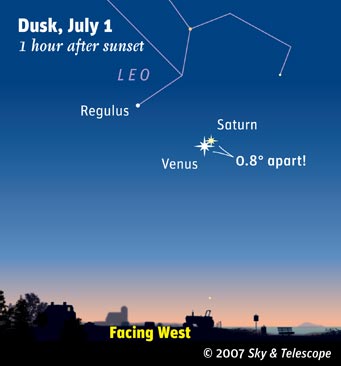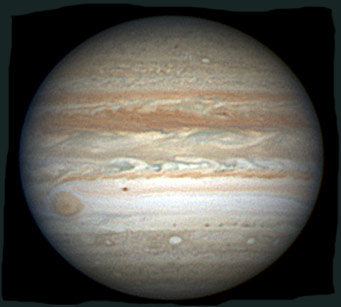Some daily events in the changing sky for June 29 – July 7.

Don't miss Venus and Saturn less than 1° apart on June 30th and July 1st. Regulus looks on from their upper left. Later in the week, Saturn moves off to Venus's right.
Sky & Telescope diagram
Friday, June 29
Saturday, June 30
Sunday, July 1
Monday, July 2
Tuesday, July 3
Wednesday, July 4
Thursday, July 5
Friday, July 6
Saturday, July 7
Want to become a better amateur astronomer? Learn your way around the constellations. They're the key to locating everything fainter and deeper to hunt with binoculars or a telescope. For an easy-to-use constellation guide covering the whole evening sky, use the big monthly foldout map in each issue of Sky & Telescope, the essential magazine of astronomy. Or download our free Getting Started in Astronomy booklet (which only has bimonthly maps).
Once you get a telescope, to put it to good use you'll need a detailed, large-scale sky atlas (set of maps; the standard is Sky Atlas 2000.0) and good deep-sky guidebooks (such as Sky Atlas 2000.0 Companion or the enchanting though dated Burnham's Celestial Handbook). Read here how to use them most effectively.
More beginners' tips: "How to Start Right in Astronomy".
This Week's Planet Roundup
Mercury is hidden in the glare of the Sun.
Venus (magnitude –4.6, in Leo) is the brilliant "Evening Star" rather low in the west during twilight. It's having a conjunction with fainter Saturn as the week opens, then Saturn slides off to Venus's right in the days following. Both planets, meanwhile, are sinking lower in the dusk. In a telescope, watch as Venus wanes to a more and more spectacular thin crescent.
Mars (magnitude +0.7, in Aries) is gradually getting higher in the eastern sky before dawn. But in a telescope, Mars is still just a tiny 6 arcseconds wide.

Jupiter's Great Red Spot is rotating into view around Jupiter's celestial east (following) limb in this June 5th image by Christopher Go. Note the very dark red dot, tiny but persistent, to the Great Red Spot's right in the south component of the now-divided South Equatorial Belt. Large white ovals populate the latitude of the South South Temperate Belt. The festoon activity in the Equatorial Zone continues to show weird variety. North is up.
Jupiter (magnitude –2.5, in southern Ophiuchus) is a month past opposition. It glares in the southeast to south during evening — you can't miss it. Antares, less bright, sparkles 5° or 6° to Jupiter's lower right. The two will remain evening companions all summer.
Saturn (magnitude +0.6, in Leo) begins the week in a lovely close conjunction with Venus, then moves off to Venus's right, as described above. Dimmer Regulus, meanwhile, is moving in from the upper left. Higher above them is 2nd-magnitude Gamma Leonis.
Uranus (magnitude 5.8, in Aquarius) and Neptune (magnitude 7.9, in Capricornus) are well up in the southeast and south, respectively, before the first light of dawn.
Pluto (magnitude 13.9, in the northwestern corner of Sagittarius) is not far from Jupiter in the south in late evening. Finder charts for Uranus, Neptune, and Pluto are in the July Sky & Telescope, page 60.
All descriptions that relate to your horizon — including the words up, down, right, and left — are written for the world's midnorthern latitudes. Descriptions that also depend on longitude (mainly Moon positions) are for North America. Eastern Daylight Time (EDT) equals Universal Time (UT, UTC, or GMT) minus 4 hours.
To always get the up-to-date Sky at a Glance, bookmark this URL:
http://SkyTonight.com/observing/ataglance .
 0
0
Comments
You must be logged in to post a comment.